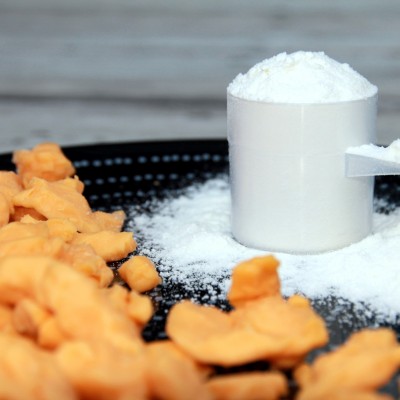
In our last post, we talked about what protein is, how much you need, and where to get it.
Invariably, when you start talking about protein, the topic of protein supplementation comes up. We all know that we should hit our protein numbers, but how much do we know about that powder we’re scooping into our smoothies?
What IS Whey Protein?
Whey is one of the two protein fragments that makes up dairy protein. The other is casein (the curds), hence the fateful meal of Little Miss Muffet. Whey is the water-soluble part, about 20-30%, of milk protein. Like other proteins, whey is amino acid groups formed into peptides. Whey is absorbed faster than most other forms of protein, which suggests that it’s good choice for your post-training protein. Most whey protein comes from cows, but it can be made from any milk-producing animal. Heightened protein intake (including from whey) can worsen pre-existing liver or kidney issues, so consult your doc if you have such a condition. It’s also a milk product, so if you’re lactose intolerant, find another protein option.
Why are there so many types of Whey Protein powder?
Most of the different types of protein powder refer to levels of processing:
Whey Concentrate: least processed, 30-80% protein by weight (usually 80% in supplements)
Whey Isolate: more than 90% protein by weight
Whey Hydrolysate: smallest particles, hence fastest absorption, process reduces allergic potential (hence why this type of protein is used in infant formula)
Once you get past the differences in composition, you can have differences in additives (probiotics, flavourings, artificial sweeteners, etc.) and sources (grass-fed cows – pricey!, non-hormone-treated cows, cows of various origins). Unflavoured whey is often described as bitter or sour (which is total bull – Ha! Bovine humour!), I don’t mind it one bit, BUT this is why it’s often flavoured, though table salt will also combat the taste. The fancier the flavour, the more likely it is that you’re going to find artificial sweeteners in your protein.
What’s Casein?
Casein is the insoluble part, about 80%, of milk protein – the part that gets used to make cheese. Casein is absorbed more slowly than whey, which makes it a great before bed option, but a less than optimal post-workout protein. If you want to use casein post-training, mix it with whey to speed up your body’s ability to use the protein. This will also help your pocketbook, since casein is more expensive than whey. Just like whey, casein is not for the lactose intolerant.
What about Vegan Proteins?
There’s a HUGE variety of vegan protein available out there. Each one will also have a slightly different amino acid profile depending on the company and the product. Remember the last post when we talked about Essential Amino Acids (the ones that need to come from food)? The biggest difference in vegan proteins is whether they contain a complete protein (all 10 essential AAs) or an incomplete one (less than all 10).
Popular vegan protein powder sources include;
Hemp – Hemp is a complete protein, high in EFAs (Essential Fatty Acids, like those found in fish oil), hypoallergenic, and high in fiber. Because of all of these great benefits, it’s also the most expensive vegan protein.
Soy – Soy is another complete protein, and may improve immune function, and bone health. However, soy is one of the most heavily genetically modified crops. A lot of our food is chock full of soy already, which raises questions about whether we should be supplementing with more.
Brown Rice – Rice protein offers complex carbs, vitamin B, and fiber, and is hypoallergenic and easily digestible (meaning it’s used by the body, not discarded as waste). It is not a complete protein.
Pea (from yellow split pea) – Like rice, pea protein is hypoallergenic, and has a 98% digestion rate. It’s also filling, and tends not to have many additives. Pea protein is mostly complete, but can be deficient in some essential AAs. Many companies also offer a pea/rice protein blend.
Just as with whey, there are endless variances – flavours, additives (greens, lecithin for moistening, BCAAs, etc.). Again, you should research what you want (and don’t want) in your powder.
What Are BCAAs?
Branched Chain Amino Acids (or BCAAs) refer to Leucine, Isoleucine, and Valine, 3 Essential Amino Acids. Leucine plays a role in muscle protein synthesis, isoleucine kickstarts glucose intake into cells, they’re still researching exactly what valine does. Many protein sources (like meat and eggs) already have BCAAs, but often folks will supplement to maintain energy during hard training. The rationale is as follows:
Hard Exercise – BCAA decline – Tryptophan influx into the brain – Serotonin production – Fatigue
Some folks swear by BCAAs to fuel their workout or game. That said, when you look at peer-reviewed studies, the science is promising, but not conclusive.
What about weight gainers?
Weight gainers are usually protein powders, combined with high carb ingredients. They’re intended to help you put on mass to convert to muscle by providing a calorie-dense supplement. As you might expect, they’re often full of artificial flavours, sweeteners, and fillers. If you’re looking to bulk up, try to find whole food to pack in those calories first – eggs, nuts, seeds, avocados, oats, and sweet potatoes are all good, calorically-dense places to start. Sure, gaining powders make it easier to get the calories in, but make sure they’re quality calories.
And meal replacements?
Many supplement companies offer a “complete shake”, so that you don’t have to use any ingredients but theirs. These are often marketed as meal replacements for weight loss, as “on-the-go” meal options, and so on. They’re all the same thing though – liquid nutrition with no whole food source. Does that mean they’re no good? Absolutely not, but as with everything else you put into your body, you should be educated about what’s coming in and why.
In our upcoming video post, Booty and I will try out some of these shakes, break down the ingredients, and experiment with the most nutritionally complete/fastest/least expensive ways to get your protein.
Will it really help?
Take all of the protein supplementation info with a grain of salt, since the science is pretty divided on the exact nature of the benefits. Try to get your required daily protein from whole food sources, then supplement, not the other way around.
For more info:
http://examine.com/supplements/Whey+Protein/
http://www.bodybuilding.com/fun/protein3.htm
Tell us:
Do you have a favourite protein supplement? How do you like to use it? Give us all your secrets in the comments below!!

 Fresh Meat – You Got This!
Fresh Meat – You Got This!  Stop sucking. Start winning.
Stop sucking. Start winning.  The Top Ten Exercises for Roller Derby Athletes
The Top Ten Exercises for Roller Derby Athletes  Cross-Training for Roller Derby: A Primer
Cross-Training for Roller Derby: A Primer  How to Improve at Derby’s 27 Laps Test
How to Improve at Derby’s 27 Laps Test